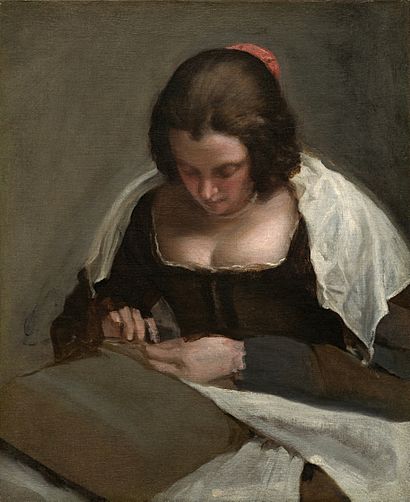The Needlewoman facts for kids
Quick facts for kids The Needlewoman |
|
|---|---|
| Spanish: La costurera | |
 |
|
| Artist | Diego Velázquez |
| Year | c. 1635-1643 |
| Medium | Oil on canvas |
| Dimensions | 74 cm × 60 cm (29 in × 24 in) |
| Location | National Gallery of Art, Washington, D.C. |
The Needlewoman (which means La costurera in Spanish) is a famous painting by the Spanish artist Diego Velázquez. He painted it sometime between 1635 and 1643. This artwork is made with oil paint on a canvas, which is a common way to create paintings. Today, you can see The Needlewoman at the National Gallery of Art in Washington, D.C., USA.
Contents
What is The Needlewoman About?
The Needlewoman is a special kind of painting called a portrait. A portrait is a picture of a person. This painting is not completely finished, which makes it interesting to study. The most detailed part of the painting is the person's head, where Velázquez used light and shadow to make it look very real.
How Velázquez Painted the Figure
The arms and hands in the painting are only lightly sketched. This shows how Velázquez worked quickly to capture the main idea of the person. He was very good at showing movement and feeling with just a few brushstrokes. He also made the person seem to blend into the background, giving the painting a soft, natural look.
Who is the Person in the Painting?
People have noticed that the person in The Needlewoman looks a lot like the person in another one of Velázquez's paintings, called The Lady with a Fan. Not only do their faces look similar, but the way Velázquez painted them is also alike.
Even though we don't know for sure who the person is, some art experts think it might be Francisca Velázquez del Mazo. She was the artist's own daughter. If it really is his daughter in both paintings, it suggests that Velázquez felt close to the person he was painting. This closeness might have helped him capture her personality so well.
See also
 In Spanish: La costurera para niños
In Spanish: La costurera para niños
- List of works by Diego Velázquez

